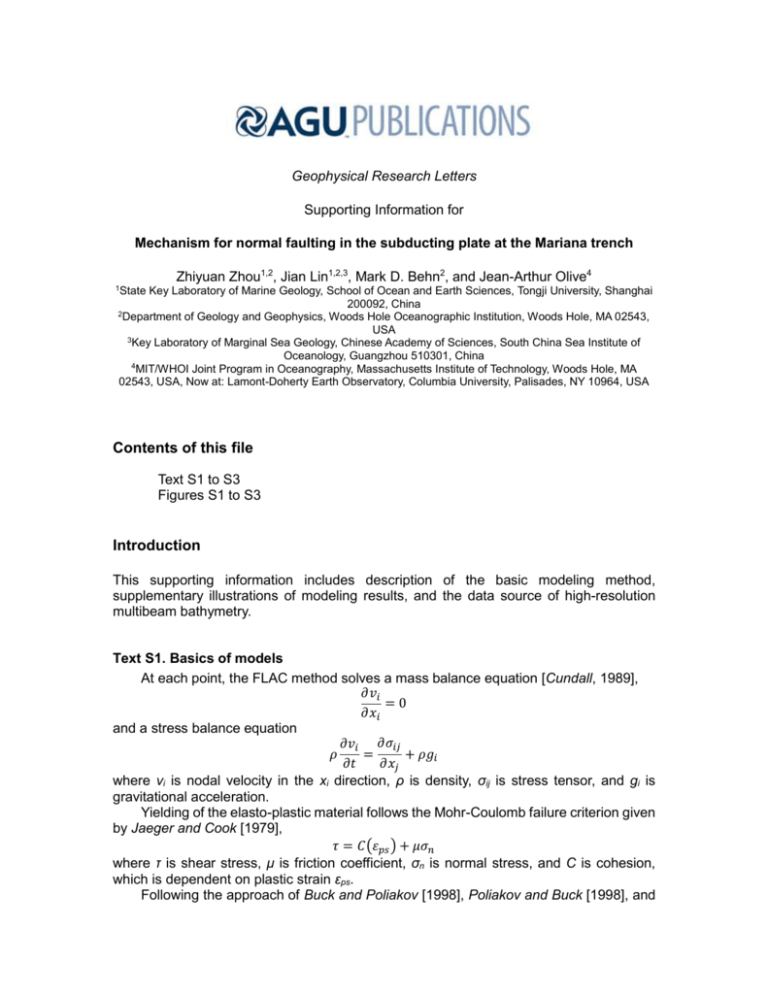grl52990-sup-0001-supinfo
advertisement

Geophysical Research Letters
Supporting Information for
Mechanism for normal faulting in the subducting plate at the Mariana trench
Zhiyuan Zhou1,2, Jian Lin1,2,3, Mark D. Behn2, and Jean-Arthur Olive4
1State
Key Laboratory of Marine Geology, School of Ocean and Earth Sciences, Tongji University, Shanghai
200092, China
2Department of Geology and Geophysics, Woods Hole Oceanographic Institution, Woods Hole, MA 02543,
USA
3Key Laboratory of Marginal Sea Geology, Chinese Academy of Sciences, South China Sea Institute of
Oceanology, Guangzhou 510301, China
4MIT/WHOI Joint Program in Oceanography, Massachusetts Institute of Technology, Woods Hole, MA
02543, USA, Now at: Lamont-Doherty Earth Observatory, Columbia University, Palisades, NY 10964, USA
Contents of this file
Text S1 to S3
Figures S1 to S3
Introduction
This supporting information includes description of the basic modeling method,
supplementary illustrations of modeling results, and the data source of high-resolution
multibeam bathymetry.
Text S1. Basics of models
At each point, the FLAC method solves a mass balance equation [Cundall, 1989],
𝜕𝑣𝑖
=0
𝜕𝑥𝑖
and a stress balance equation
𝜕𝑣𝑖 𝜕𝜎𝑖𝑗
𝜌
=
+ 𝜌𝑔𝑖
𝜕𝑡
𝜕𝑥𝑗
where νi is nodal velocity in the xi direction, ρ is density, σij is stress tensor, and gi is
gravitational acceleration.
Yielding of the elasto-plastic material follows the Mohr-Coulomb failure criterion given
by Jaeger and Cook [1979],
𝜏 = 𝐶(𝜀𝑝𝑠 ) + 𝜇𝜎𝑛
where τ is shear stress, μ is friction coefficient, σn is normal stress, and C is cohesion,
which is dependent on plastic strain εps.
Following the approach of Buck and Poliakov [1998], Poliakov and Buck [1998], and
Lavier et al. [2000], we assume the cohesion is reduced with increasing plastic strain:
(𝐶0 − 𝐶1 )𝜀𝑝𝑠
𝐶(𝜀𝑝𝑠 ) = 𝐶0 −
, 𝜀𝑝𝑠 ≤ 𝜀𝑐
𝜀𝑐
{
𝐶(𝜀𝑝𝑠 ) = 𝐶1 , 𝜀𝑝𝑠 > 𝜀𝑐
where C0 is initial cohesion for brittle material, C1 is remaining cohesion when totally
yielded, and εc is the characteristic plastic strain that controls the slope of cohesion
reduction.
The rheological behavior of viscous material follows non-Newtonian power-law
rheology given by Chen and Morgan [1990], which depends on temperature and strain
rate,
1−𝑛
1 4
𝑄
𝑛
𝜂 = ( )1/𝑛 𝑒̇𝑚𝑎𝑥
exp(
)
4 3𝐴
𝑛𝑅𝑇
√2
where 𝑒̇𝑚𝑎𝑥 = 𝑒𝐼𝐼̇ , 𝑒𝐼𝐼̇ is the second invariant of the strain rate tensor, A is pre2
exponential factor, n is creep exponent, Q is activation energy, R is gas constant, and T is
temperature.
Text S2. Effect of horizontal tensional force on calculated normal faulting
characteristics
Model results suggest that when the horizontal tensional force F0 increases, the
distance of maximum fault throw is calculated to move towards the trench axis (Figure
S3a). This implies that F0 could help to concentrate normal faults towards the trench axis.
The observed distance of maximum fault throw is 10-35 km from the trench axis for the
southern Mariana trench (Figure S3b). Panel b shows that best-fitting models without F0,
which can explain well the calculated non-isostatic topography, but can not explain the
observed distance of maximum fault throw of the southern Mariana trench. In contrast,
best-fitting models with F0 can explain the calculated non-isostatic topography as well as
the distance of maximum fault throw.
Text S3. Source of high-resolution multibeam bathymetry data
The high-resolution bathymetry data are downloaded from the National Geophysical
Data Center (NGDC, http://www.ngdc.noaa.gov) and Global Multi-Resolution Topography
Synthesis (GMRT) [Ryan et al., 2009].
Figure S1. Shade maps of topography illustrating normal faults at the northern, central,
and southern Mariana trench. Locations of these three regions are marked by dashed
boxes in Figure 1a. Red lines show trench axes. White lines show across-trench profiles
for analysis. Black dashed lines in panel c show the approximate location of the central
part of the outer-rise region, which was determined from the shallowest point on acrosstrench profiles of non-isostatic topography. Blue beach balls show normal faulting
earthquake focal mechanisms from Global CMT (http://www.globalcmt.org) for events with
magnitude greater than Mw 4.5.
Figure S2. RMS between the calculated non-isostatic topography and model topography
as a function of applied tectonic forcing.
Figure S3. (a) Distance of maximum fault throw as a function of F0 for fixed V0 and M0
values. (b) Distance of maximum fault throw as a function of V0 for best-fitting models with
and without F0. Grey columns indicate the observed distance of maximum fault throw from
the trench axis at the southern Mariana trench.
References:
Buck, W. R., and A. N. Poliakov (1998), Abyssal hills formed by stretching oceanic
lithosphere, Nature, 392, 272-275.
Chen, Y., and W. J. Morgan (1990), A nonlinear rheology model for mid-ocean ridge axis
topography, J. Geophys. Res., 95, 17583-17604.
Cundall, P. A. (1989), Numerical experiments on localization in frictional materials,
Ingenieur-archiv, 59, 148-159.
Jaeger, J. C., and N. G. Cook (1979), Fundamentals of Rock Mechanics, Chapman and
Hall, London, pp. 513.
Lavier, L. L., W. R. Buck, and A. N. Poliakov (2000), Factors controlling normal fault offset
in an ideal brittle layer, J. Geophys. Res., 105, 23431-23442.
Poliakov, A. N., and W. R. Buck (1998), Mechanics of stretching elastic-plastic-viscous
layers: Applications to slow-spreading mid-ocean ridges, in Faulting and Magmatism
at Mid-Ocean Ridges, Geophys. Monogr., Ser., vol. 106, edited by W. R. Buck, P. T.
Delaney, J. A. Karson, Y. Lagabrielle, AGU, Washington, D. C., pp. 305-323.
Poliakov, A. N., P. A. Cundall, Y. Y. Podladchikov, and V. A. Lyakhovsky (1993), An explicit
inertial method for the simulation of viscoelastic flow: An evaluation of elastic effects
on diapiric flow in two- and three-layers models, in Flow and Creep in the Solar
System: Observations, Modeling and Theory, Kluwer Acad. Pub., pp. 175-195.
Ryan, W. B. F., Carbotte, S. M., Coplan, J. O., O'Hara, S., Melkonian, A., Arko, R., Weissel,
R. A., Ferrini, V., Goodwillie, A., Nitsche, F., Bonczkowski, J., Zemsky, R. (2009),
Global multi-resolution topography synthesis, Geochem. Geophys. Geosyst., 10,
Q03014.







